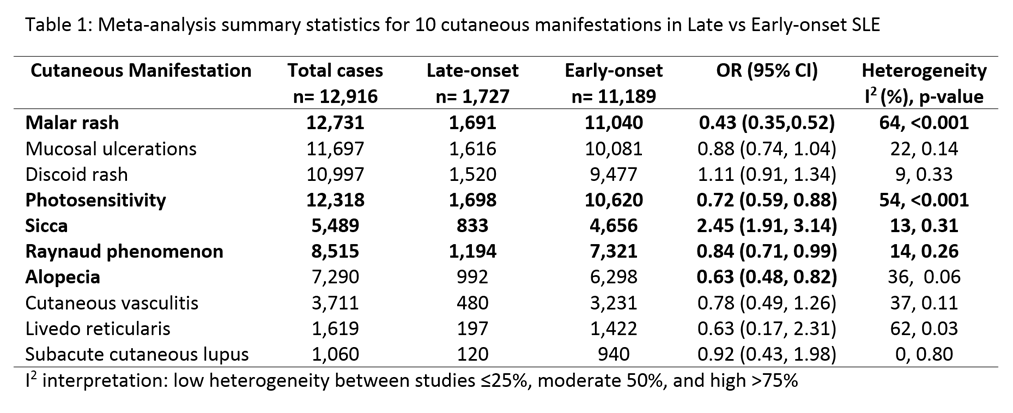Session Information
Date: Tuesday, November 10, 2015
Title: Systemic Lupus Erythematosus - Clinical Aspects and Treatment Poster Session III
Session Type: ACR Poster Session C
Session Time: 9:00AM-11:00AM
Background/Purpose: Systemic lupus erythematosus (SLE) is
commonly diagnosed in females of reproductive age, with those diagnosed after the
age of 50 referred to as late-onset SLE. Most prior studies comparing late and
early-onset SLE manifestations were limited by small sample sizes. The last
meta-analysis (Ward 1989) included just 9 studies. Given that more than one
third of SLE classification criteria are cutaneous, we performed a systematic
literature review and meta-analysis to assess the clinical differences in
cutaneous manifestations between late and early-onset SLE.
Methods: Systematic review of the literature
from inception through August 2013 was performed using PubMed, CINAHL, Web of
Science, and Cochrane Library. We excluded studies that did not require the ACR
SLE classification criteria, had no early-onset controls, defined late-onset
SLE as <50 years of age, or were non-English language. The quality of the
eligible studies was evaluated using Newcastle Ottawa Quality Scale. Forest plots were created using random
effects models to compare rates of cutaneous manifestations by age of onset.
Study heterogeneity was assessed using I2.
Results: Thirty five studies, representing 1,727
late-onset and 11,189 early-onset SLE patients, met eligibility criteria. The female:
male ratio was smaller in the late-onset group (5:1 versus 8:1, p<0.001, I2
7.5%). Most cutaneous
manifestations were less prevalent in the late-onset group, including malar
rash (OR 0.43 (0.35, 0.52)), photosensitivity (OR 0.72 (0.59, 0.88)), alopecia
(OR 0.63 (0.48; 0.82)), and Raynaud’s phenomenon (OR 0.84 (0.71-0.99)). By
contrast, sicca was more common in late versus early-onset SLE (OR 2.45 (1.91,
3.14)). Other cutaneous manifestations including mucosal ulcerations, discoid
rash, cutaneous vasculitis, livedo, and subacute cutaneous lupus did not differ
significantly. The mean Newcastle Ottawa Quality Scale score was 6.3±0.5 out of
9 possible points.
Conclusion: Many cutaneous manifestations were less
common overall in late-onset SLE patients with the exception of sicca symptoms,
consistent with prior studies. Increased sicca in late-onset lupus was also
reported in a meta-analysis restricted to that topic (Yao 2012). Late-onset SLE
with sicca symptoms might represent a distinct disease entity with
characteristic features including milder disease course. Future studies should investigate etiologies for these
phenomena including roles of genes, gender, immune senescence, environment, and
isolated cutaneous versus systemic lupus prevalence in older adults.
To cite this abstract in AMA style:
Medlin J, Hansen KE, Fitz S, Bartels CM. A Systematic Review and Meta-Analysis of Cutaneous Manifestations in Late Versus Early-Onset Systemic Lupus Erythematosus [abstract]. Arthritis Rheumatol. 2015; 67 (suppl 10). https://acrabstracts.org/abstract/a-systematic-review-and-meta-analysis-of-cutaneous-manifestations-in-late-versus-early-onset-systemic-lupus-erythematosus/. Accessed .« Back to 2015 ACR/ARHP Annual Meeting
ACR Meeting Abstracts - https://acrabstracts.org/abstract/a-systematic-review-and-meta-analysis-of-cutaneous-manifestations-in-late-versus-early-onset-systemic-lupus-erythematosus/

